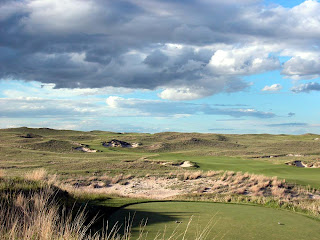1990 – 2000 The decade of Contrasting Styles
This is one of the most interesting decades due to the explosive divisions in architectural philosophy practiced by a series of high profile architects. You have Rees Jones continuing on the legacy of his father with his new work like Atlantic Golf Club. His renovation work at Bethpage Black and other famous layouts provides him with the “Open Doctor” moniker just like his dad had and he become the USGA’s go to guy – like his dad. Nicklaus continues to work on hundreds of projects with many being outside the US, but gets into financial problems with the development and construction arm of his company. Pete Dye becomes the very antithesis of his early origins, while he continues with the remarkable design ideas that brought him to prominence, he now shapes and moves everything – a far cry from The Golf Club. His courses are still strategically excellent and fascinating, but the work lacks the same charm of the early courses. This culminates at Whistling Straights where he takes an average albeit lakefront property and moves millions of yards of earth to build a stunning “links” layout with so many bunkers that nobody has ever counted them.

Whistling Straights 17th
Mike Strantz, who had previously worked for Tom Fazio, was an architect walking completely out of step with all other – to my delight. The first signs of his genius are with a small tight property at Caledonia where he builds a remarkably clever and interesting layout that is a little different looking and playing than what people are used to. But there was so much more to come when you listen to this quote from an interview, “It is important to make the golf hole look more difficult than it really is." That is almost always the case on our courses, but if your mind convinces you that it really is a difficult shot, you’re beat before you even take the club back.” Caledonia was tricky in places but when he built Tobacco Road he built the most intimidating and controversial course constructed in recent time. This course is either loved or hated. I personally think this is because the course needs to be understood and respected before you can try out play it. The course uses large doses of intimidation – including blind shots – to overwhelm the player into playing in fear. The course also has width and short cuts galore to encourage a risky style of play, add this all up and you have one of the most unique and entertaining courses I have played. His work eventually softened culminating with his last course - the sublime Monterey Peninsula Shore Course - but one thing you can say about Mike’s work is that it was always interesting.

The 13th at Tobacco Road
The final prominent architect of the decade is Bill Coore. Bill began working with Pete Dye as a superintendent but became interested in architecture working on a few smaller jobs. He became involved with Ben Crenshaw and began to design so very lay of the land layouts with lots of interesting ground options and alternate strategies. The work caught immediate attention for the enjoyment in created when you played the courses. Everything changed overnight when they were asked to do Sand Hills in the middle of the Sand Hill country in Nebraska. Sand Hills was an exceptional property. Coore and Crenshaw showed the patience to walk and walk the property until they had found the right routing. While 100’s of perfect holes were available, they walked until they found a routing that would work, without having to disturb any of the natural site. Many of the hazards are natural blow outs, and others that were created to look like they were also blow outs too. The course is like Prairie Dunes where the line between golf and nature is blurred. The golf course is a perfect reflection of the site, has a perfect set of holes and will be this era’s greatest course.

The 17th at Sand Hills
Bill Coore caught everyone’s attention and ultimately ushered in a new movement called Minimalism. It may have originated with the Golden Age, been picked up by Pete Dye with The Golf Club, been regenerated with Tom Doak’s High Pointe, but it was Coore and Crenshaw that really made the statement that this movement was here to stay. They built the ultimate example at Sand Hills and then built a series of excellent examples at other less spectacular sites. Now their style has been copied by all the other architects including Nicklaus and fazio. Coore and Crenshaw became the trend setters.


1 comment:
Successful betting: top 10 tips and rules from OddsDigger. Great offers for bettors are always here.
Post a Comment